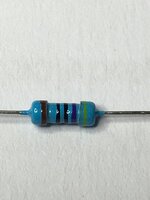A much easier method is to connect the resistor to a battery, set the meter to volts, and then measure the voltage accross the ends. Then set the meter to amps, disconnect one battery terminal from the circuit and then connect one meter lead to the battery and the other to the end of the resistor which is not connected to the battery. Then simply divide your voltage reading by your amps reading, add any number between one and ten, then subtract it again, and, as if by magic, you will have the resistance of your resistor. Simples.




